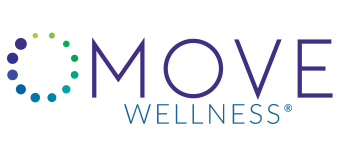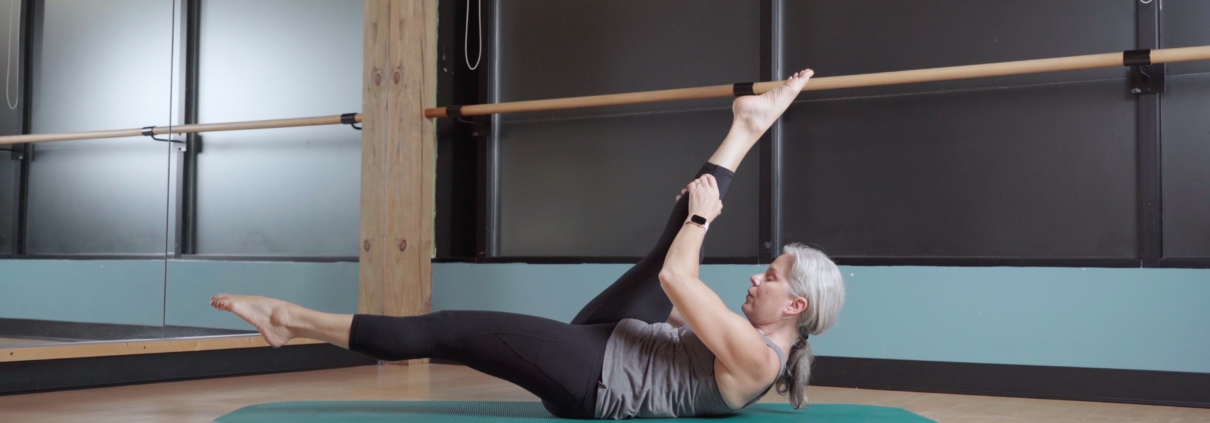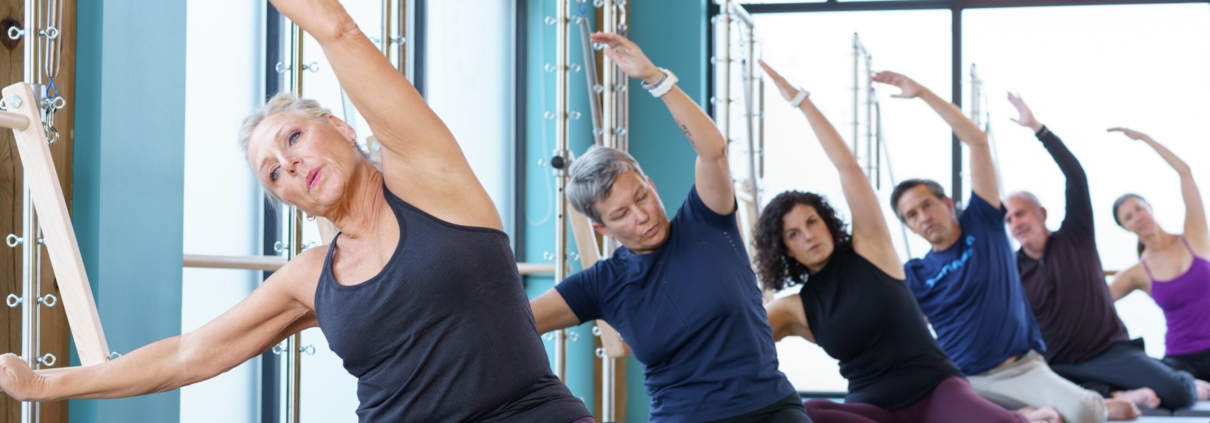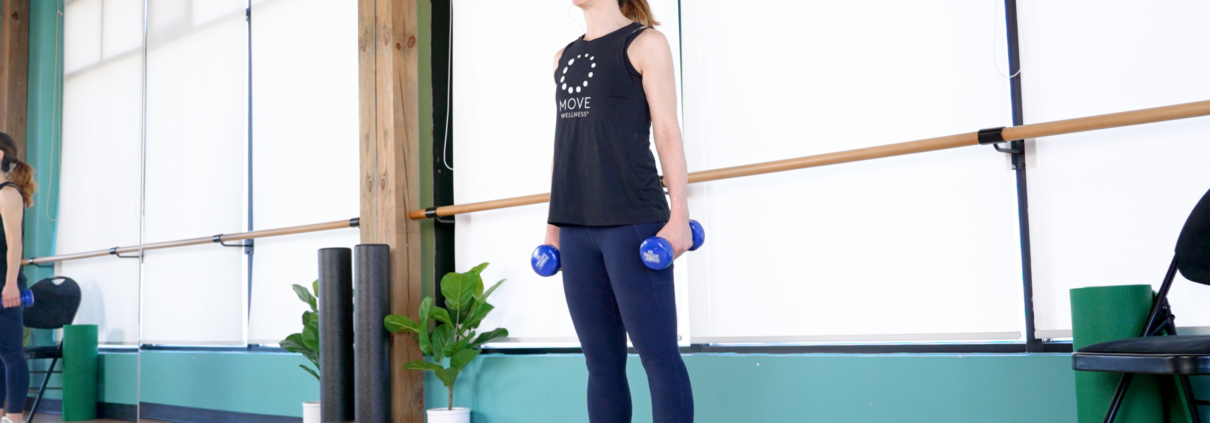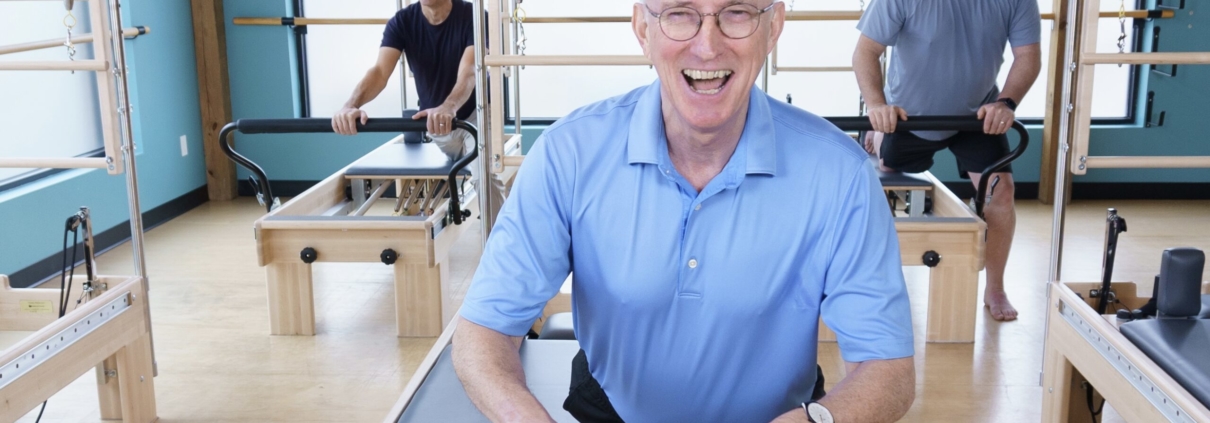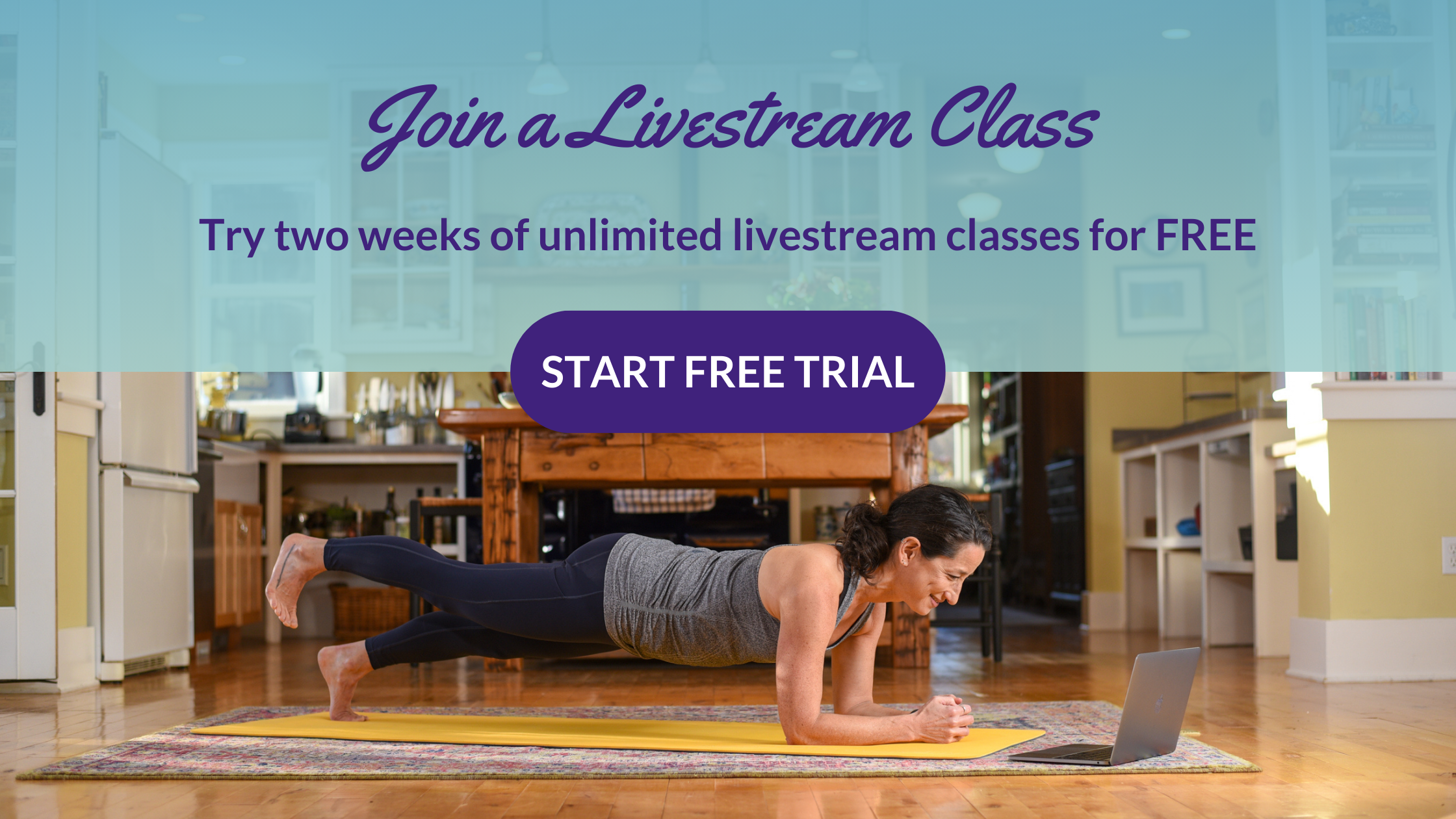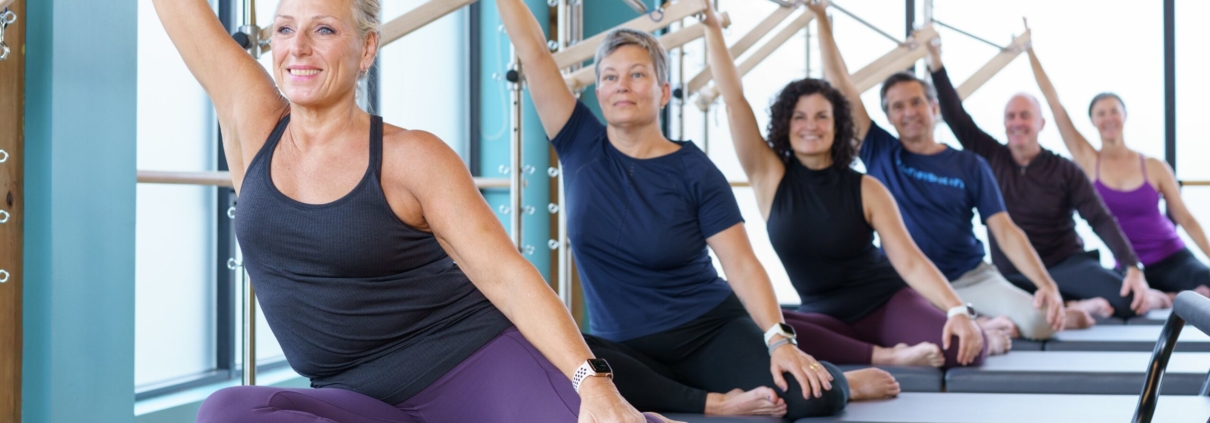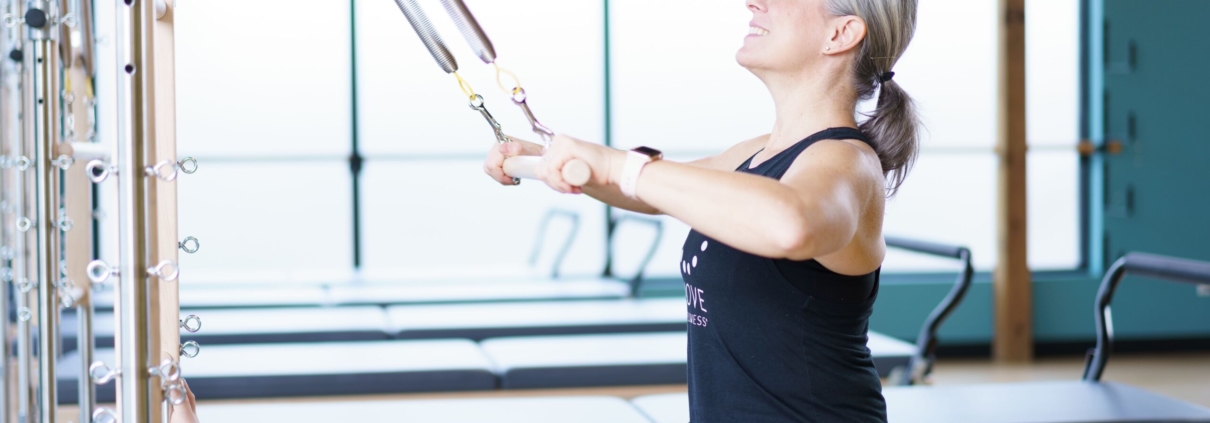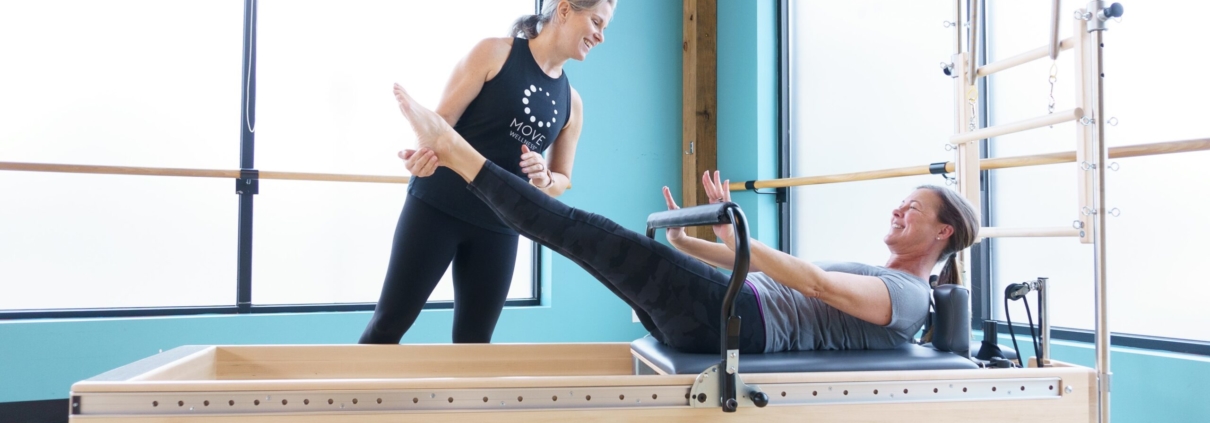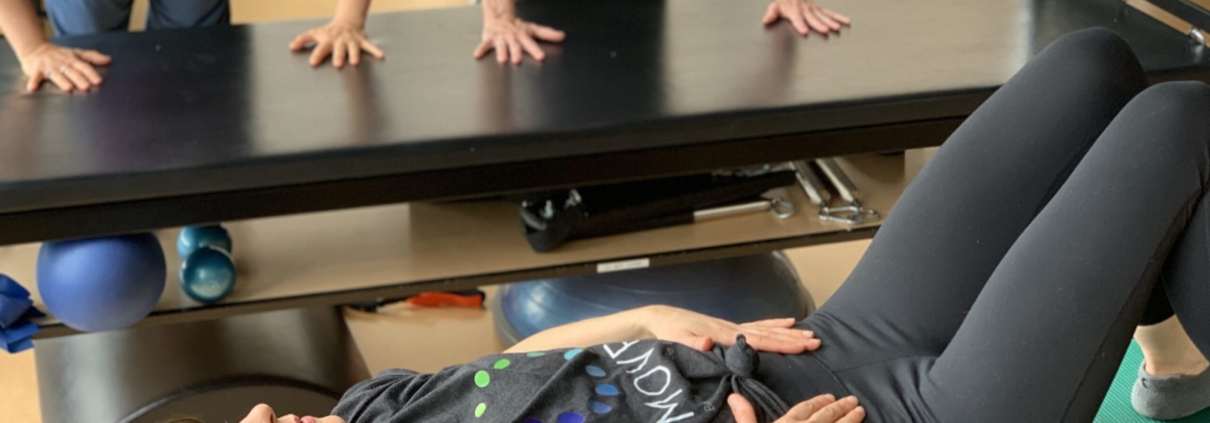Now available at MOVE On Demand
Movement Essentials: Foundations in Pilates is a 28-day program designed to set you on a path to feeling stronger and more confident in your movement. Each week Elaine Economou will introduce you to the foundational principles of Pilates exercises with a warm up, weekly classes, and a variety of special topics to enhance your journey. The program comes with an easy-to-follow calendar that will guide you through a clear progression and provide a foundation for healthy movement.
Movement Essentials is the first step in understanding your body and getting to know your own movement patterns. If you are ready to add Pilates to your fitness routine, this program will set you up for long term success. If you are familiar with Pilates, you will expand your knowledge and understanding to deepen your personal practice. You’ll get stronger safely, effectively, and efficiently while building healthy habits and consistency into your fitness routine. All in the comfort of your own home.
Start here if…
- You have Pilates experience or have completed Movement Essentials: Gentle Pilates for Everyday Life
- You’re ready to move at a faster pace
- You’re looking to supplement your current exercise program with Pilates
What to Expect in the Program:
- To be challenged by a faster pace
- Practice using correct form to get the most out of an exercise
- Movements that support other exercise programs (walking, running, tennis, golf, etc.)
- Learning how to set a solid movement foundation
- Working towards a 20-30 second plank
- Completing the full Pilates hundred
- Moving the spine in all the planes of motion
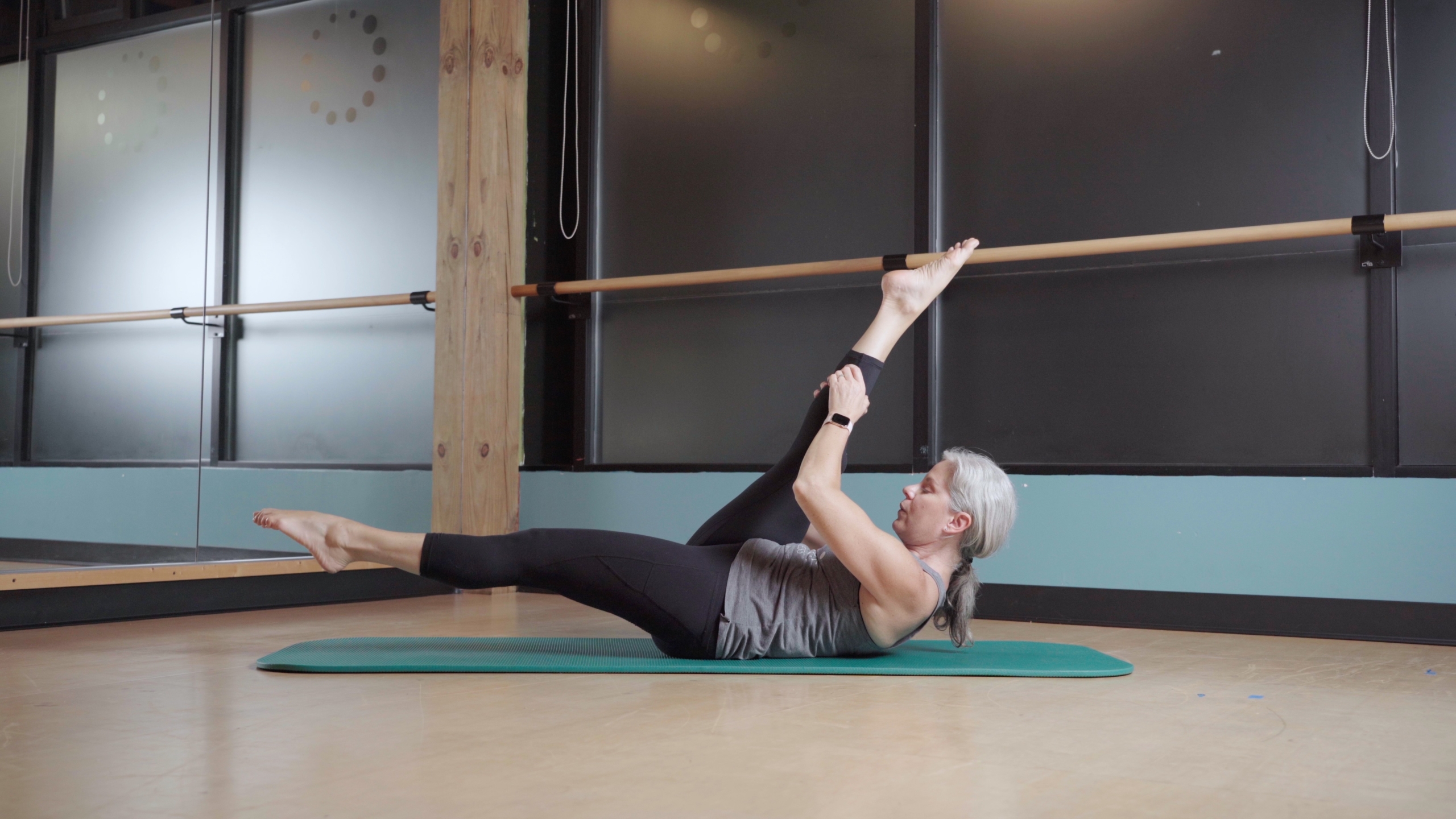
What’s included in the full program?
Movement Essentials: Foundations in Pilates includes:
- A series of introductory topics to deepen your knowledge and set the stage for your personal journey
- 1 weekly warm up routine—make sure your body is ready for movement each week
- 2 weekly Pilates classes—customize your journey by doing each class once or twice each week
- 1 weekly special topics class—including feet, core, fascia, and posture
- 2 printable calendars—follow along and keep yourself accountable
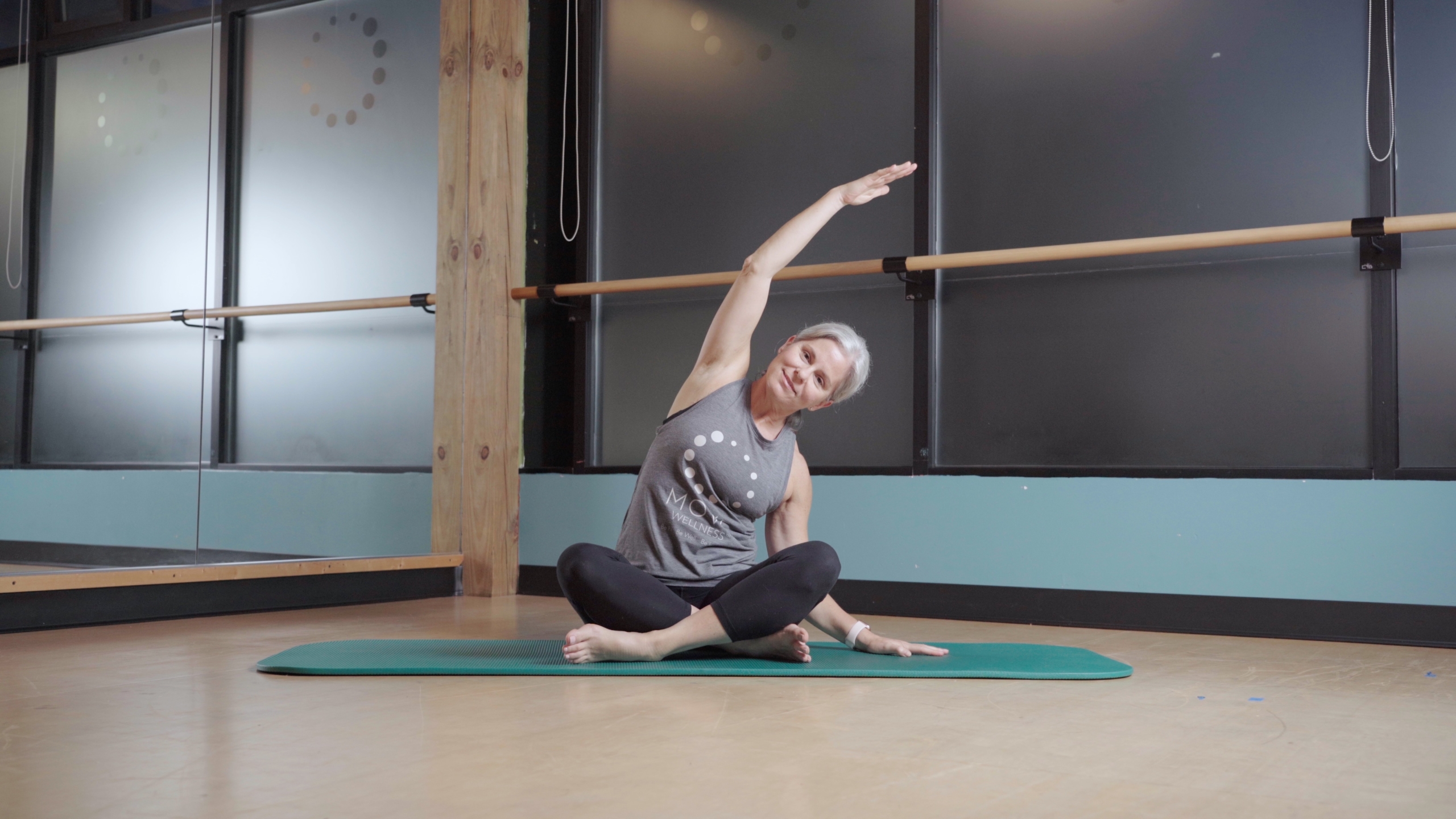
Are you ready to start moving?
“The consistency and frequency of your workout routine builds positive outcomes.”
—Elaine Economou
Now more than ever, MOVE Wellness offers a complete solution to get you moving and keep you moving. By committing to this 28-day program, you are committing to yourself. Movement Essentials: Foundations in Pilates is now available for the introductory price of $99.99 at MOVE On Demand.
MOVE Wellness Studios offers Reformer Pilates classes in Ann Arbor, MI, led by experienced trainers.
Pilates is an excellent way for men and women of all ages and fitness levels to build strength and flexibility. In Reformer Pilates, the exercises are done on specialized equipment, called a Reformer, to provide more resistance and allow for the fullest expression of movement.
Reformer Pilates is highly adaptable; when done properly, it can be modified to accommodate injuries, build endurance for beginners, or challenge even the toughest athletes.
With that in mind, our Ann Arbor studio limits Pilates classes to six people to allow for more individualized instruction. A weekly group class is a great way to get motivation, support, and accountability!
We also offer private training sessions for those who want to work one on one and enjoy a completely customized Pilates experience.
What is Reformer Pilates?
Reformer Pilates is done on a rolling platform with springs that add resistance to your Pilates workout. This allows for more dynamic movement that can train many parts of the body in different ways.
The Pilates Reformer has a bed-like frame with a flat platform on it, called the carriage, which rolls back and forth on wheels within the frame. The carriage is attached to one end of the Reformer by a set of springs. Springs can be added or taken away to provide different levels of resistance as the carriage is pushed or pulled along the frame.
The Reformer gives you more options in how you do your Pilates exercises.
Pilates exercises can be done:
- lying down
- sitting
- standing
- pushing the footbar
- perched on the footbar
- perched on the shoulder blocks
- upside down
- sideways
- and more
Can beginners do Reformer Pilates?
Yes! Reformer parts can be adjusted to your body size and level of skill, so it’s a great option for beginners.
At MOVE Wellness, we make sure that everyone feels supported by first starting with a one on one or group Pilates Essentials class so we can familiarize you with the basics.
Is Reformer Pilates better than doing mat Pilates?
Mat classes tend to focus on core work and require you to support the stabilization of your body. Equipment like the Reformer, on the other hand, provides a frame to work within.
Because the Reformer provides some support, it may feel easier than working on a mat, but your Pilates trainer can make it more challenging by adding or taking away springs. Working on the equipment can also efficiently target and tone specific areas of your body.
The type of Pilates that works best for you will depend on your body and fitness goals. Our trainers can help make recommendations if you’re unsure which class(es) you should take.
How many times a week should you do Pilates Reformer?
We recommend practicing Pilates three times per week to support neuromuscular patterning and see the most rapid change in your body.
However, we recognize that barriers like time and finances may limit the number of sessions you can do each week. We’ll work with you to customize a plan that meets your needs.
Can you lose weight doing Reformer Pilates?
Pilates helps create long, lean, fit bodies. There are many ways that doing Pilates supports weight loss, but it is also recommended that clients also eat a healthy diet and incorporate some form of cardiovascular training to boost their metabolism.
Is Reformer Pilates more expensive?
All in-studio classes at MOVE Wellness are on mixed equipment and include all aspects of Pilates. Pricing depends on whether you do private sessions or small group classes.
Reformer Pilates at MOVE Wellness in Ann Arbor, Michigan
The MOVE Wellness fitness studio is conveniently located on Jackson Road near I-94 in Ann Arbor, Michigan.
We offer both private training and small-group classes for Reformer Pilates. Each session or class is led by one of our experienced Pilates trainers so you can have a safe and effective workout, regardless of your age, fitness level, or wellness goals.
“Maintaining healthy bones is a lifelong endeavor, and it’s never too early or late to get started. When it comes to dealing with osteoporosis or osteopenia, keep this simple mantra in mind: Move more, not less.”
—Elaine Economou
Maintaining core strength, spinal strength, and mobility helps support healthy bones. Elaine Economou‘s latest blogpost for popular website Sixty and Me shares simple Pilates-based exercises to get you started.
Read the full blog post on Sixty and Me.

Best exercises for Osteoporosis
People with osteoporosis often wonder, can exercise strengthen or rebuild bone? The answer is yes, though not all exercise is equally effective at bone strengthening. There are two main types of exercise that have been shown to be most effective at strengthening bone:
- Impact and weight bearing exercise.
- Muscle strengthening exercise.
In addition to exercises to promote bone and muscle strength, The Royal Osteoporosis Society recommends exercises:
- To keep you steady (balance)
- To care for your back (posture)
Strength, Balance, Posture for Healthy Bones
For healthy bones, remember to simply move more, not less. Whether it’s going for a brisk walk (or run), dancing like nobody’s watching, or my favorite, Pilates, more movement will build strength to help you live the life you love. If you’d like to try more of our Pilates and Pilates-inspired exercises for osteoporosis, try one of our Strength, Balance, Posture classes at MOVE On Demand. We also offer a weekly livestream version, with your first class free!
Watch the trailer to learn more. Support the activities you love to do in life by starting today!
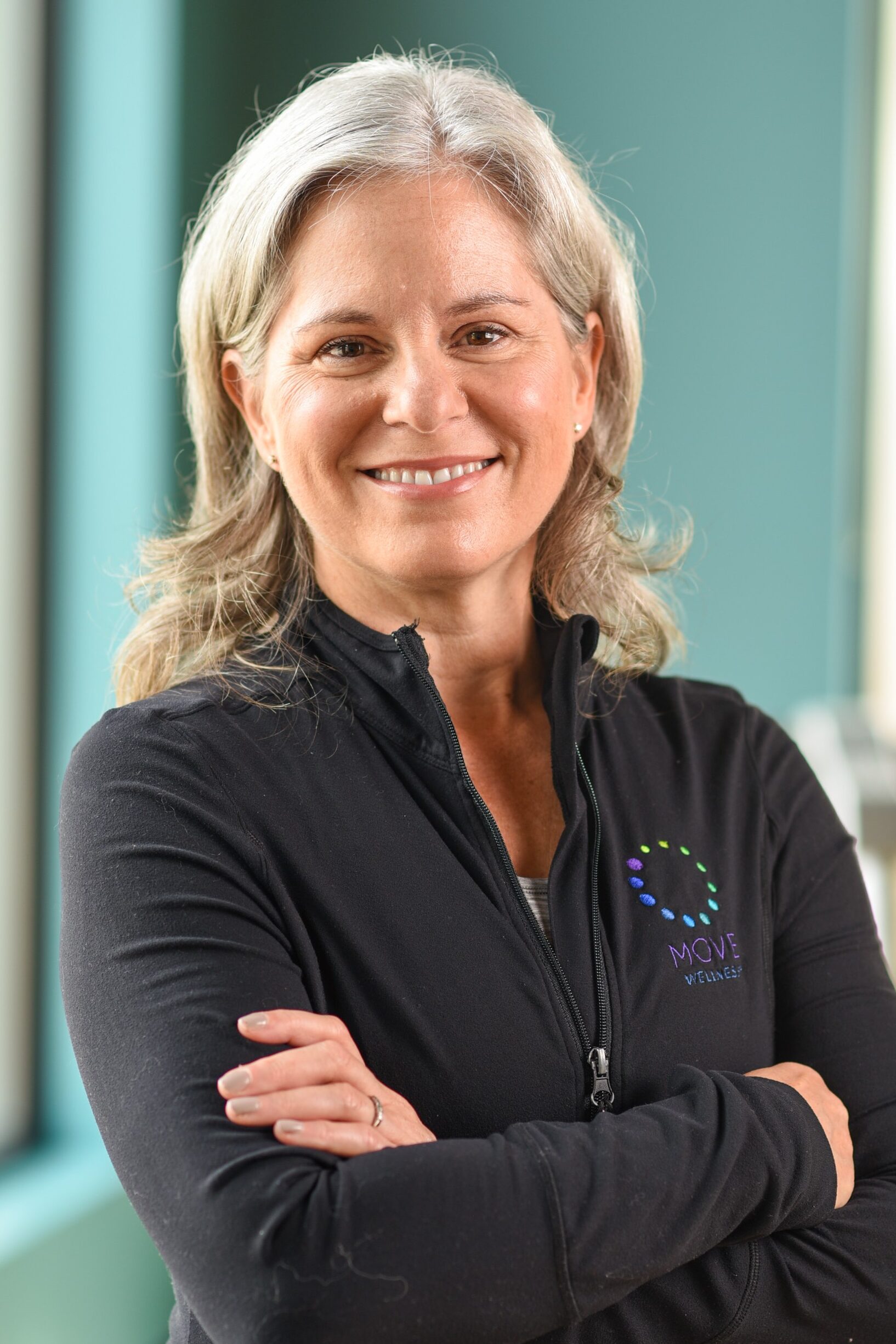
About Elaine Economou
As co-founder of MOVE Wellness®, Elaine Economou helps people move with ease, strength, and joy. Her passion is empowering people to understand their unique bodies and build strength to support moving well through their unique life. Elaine has created Movement Essentials: Getting Started with Pilates to help people move well and live a life they love – wherever and whenever.
Find all of Elaine’s Sixty and Me blogs on her author page.
Pilates for Men: Benefits of Pilates Exercise for Men
What do you think of when you picture a Pilates class? For many, ‘Pilates,’ brings up images of leggings-clad women doing light exercises that look more like stretching than an actual workout — but that’s a complete misconception.
Although Pilates doesn’t incorporate intense cardio or heavy weights, it’s still a tough workout for men and women of all ages. In fact, some of the top athletes in the world incorporate Pilates into their routines. Pilates works new muscles and movements, so it’s challenging without causing the strain some higher-impact workouts do. It is particularly effective for strengthening abdominal muscles and targeting the core.
But whether you’re a pitcher for the Chicago Cubs or a retiree looking to switch up your workout routine, you can find benefits in Pilates.
Here are answers to some common questions about Pilates, its benefits for men, and a free Pilates workout you can try from the comfort of your own home.
Try even more Pilates classes with our MOVE On Demand Series: Building a Strong Core with Pilates for Men and sign up to get your first livestream class free!
What is Pilates, exactly?
Pilates is a safe, adaptable exercise method that can be done on a mat or with a specialized Reformer machine. The Pilates method is a comprehensive workout system that uses resistance and your own body weight to stabilize your core and strengthen your body. Pilates’ adaptability makes it great for all body types and fitness levels, while still being a challenge for even the toughest athletes. This form of exercise is an efficient, effective, and safe way to increase your flexibility, develop your core, and release tension.
Pilates is versatile and offers numerous benefits for men, including improved core strength, posture, and overall body awareness. Some men dismiss Pilates as a form of exercise because it doesn’t involve high intensity cardio or heavy weightlifting. But don’t let that fool you — Pilates is a great workout that corrects muscular imbalances and builds a strong and stable core, without the impact on your joints that extreme fitness can cause.
Can you gain muscle with Pilates?
Yes. Pilates helps lengthen the muscle and build strength for men of all fitness levels.
Is Pilates good for weight loss in men?
Pilates supports weight loss by helping to create a leaner, fitter body. However, for best results, men should combine Pilates with cardio and a healthy diet.
Do men do Pilates?
Yes, we have many men in our studio who enjoy the benefits of Pilates. Top athletes, including tennis champion Andy Murray and members of the Super Bowl-winning New England Patriots, also do Pilates.
What are some benefits of Pilates for men?
Here are some benefits of Pilates that men of all ages can enjoy:
- Improved flexibility: According to Harvard Health, flexibility allows us to more easily achieve a full range of motion, which leads to both improved athletic performance (a smoother golf swing) and functional abilities (reaching and bending). Muscles get shorter and less elastic as we age, so exercises like Pilates that lengthen the muscles and improve flexibility are great for keeping you moving.
- Building strength: Pilates can be an effective strength training workout for all fitness levels; this exercise can be adapted to provide stability for beginners or provide a challenging workout for athletes.
- Alleviate pain and side effects of illness: Working the deep abs and pelvic floor can help alleviate back problems, and can be incredibly beneficial for men who have been, or will be, treated for a number of diseases. Notably, men suffering from prostate cancer have experienced notable pain relief thanks to Pilates.
- It supports weight loss: Pilates helps to create long, lean, fit bodies. There are many ways that doing Pilates supports weight loss, but it is also recommended that you eat a healthy diet and incorporate cardio to boost the metabolism.
- Safety: While high-intensity workouts are great for getting your heart pumping, they can be jarring on your joints and possibly cause injury. Pilates, especially when done with a knowledgeable trainer, is a safe, effective way to workout without the pain.
- It can be done alone or in a group: Men still wary of trying Pilates (despite the endorsement of many professional athletes!) can start off with a private Pilates session. One-on-one sessions will put you in contact with a Pilates trainer who can give you individual attention and a great introduction to this workout that’s adapted to your current fitness level. At MOVE Wellness, small group classes are limited to six students to allow for personalized instruction.
- Posture support: Pilates addresses poor posture by strengthening the muscles that support the spine and promoting better alignment, which can alleviate back and neck pain experienced by men of all ages.
- Sports performance: Pilates enhances sports performance by improving coordination, balance, and functional strength, benefiting athletic abilities in sports from golf to basketball.
Pilates as a Form of Physical Therapy
Pilates was originally developed as a form of physical therapy to help rehabilitate injured soldiers during World War I. Today, Pilates continues to be a valuable form of physical therapy, helping individuals recover from injuries and improve their overall physical fitness. For men who have suffered injuries, such as back pain or joint issues, Pilates offers a gentle yet effective way to strengthen muscles and improve flexibility and range of motion.
Pilates exercises, including mat work and reformer Pilates, can be tailored to suit different fitness levels and target specific areas of the body. This adaptability makes Pilates an ideal form of physical therapy. By incorporating Pilates into their physical therapy routine, men can enhance their overall physical fitness, reduce the risk of future injuries, and improve their athletic performance.
How quickly will you see results with Pilates?
Everyone responds differently to Pilates, but if you maintain a somewhat regular practice, you’ll see changes quickly. According to Joseph Pilates, the creator of Pilates: “10 sessions — feel the difference, 20 sessions — see the difference, 30 sessions — have a new body.”
Getting started with Pilates
Pilates can be done on a mat or with specialized equipment. Mat Pilates classes, like the 20 minute workout above, tend to focus on core work and require you to support the stabilization of your body. Pilates equipment, like the Cadillac or Reformer, gives you a frame to work within that is often more helpful than a mat, but can be more challenging when springs are added or taken away. Working on the equipment can also target and tone specific areas of your body very efficiently.
If you’re new to Pilates or fitness in general, it can be worthwhile to begin with a private Pilates session to get individualized attention and a more customized Pilates-based fitness program. You can also explore Pilates on your own and learn the Pilates basics with a beginners Pilates workout.
Pilates Workout for Men
This 20 minute Pilates workout will take you through exercises that will help with the tight hamstrings and shoulders that are common for men, but experienced by all. All you need is your mat!
Pilates is a whole-body exercise system that was created by fitness and conditioning enthusiast Joseph Pilates more than 85 years ago. Whatever your conditioning goal, Pilates is an efficient, effective, and safe way to increase your flexibility, develop your core, and release tension. While the exercises in this system work out the full body, there is a focus on breathing well and engaging the core muscles to support balanced and efficient movement. Pilates is suitable for all bodies at any stage of life.
At MOVE Wellness we believe in community, in learning from one another, finding inspiration in our individual journeys, and supporting our clients and staff. We see so much growth within the larger Pilates community and a desire to honor the work as a system that can provide whole body health to those who practice it. The evolution and innovation of Pilates along with a strong desire to increase opportunities for everyone to access the system, makes it a great time to be a part of this industry. We do this work because we are a network of motivated individuals committed to changing lives through movement.
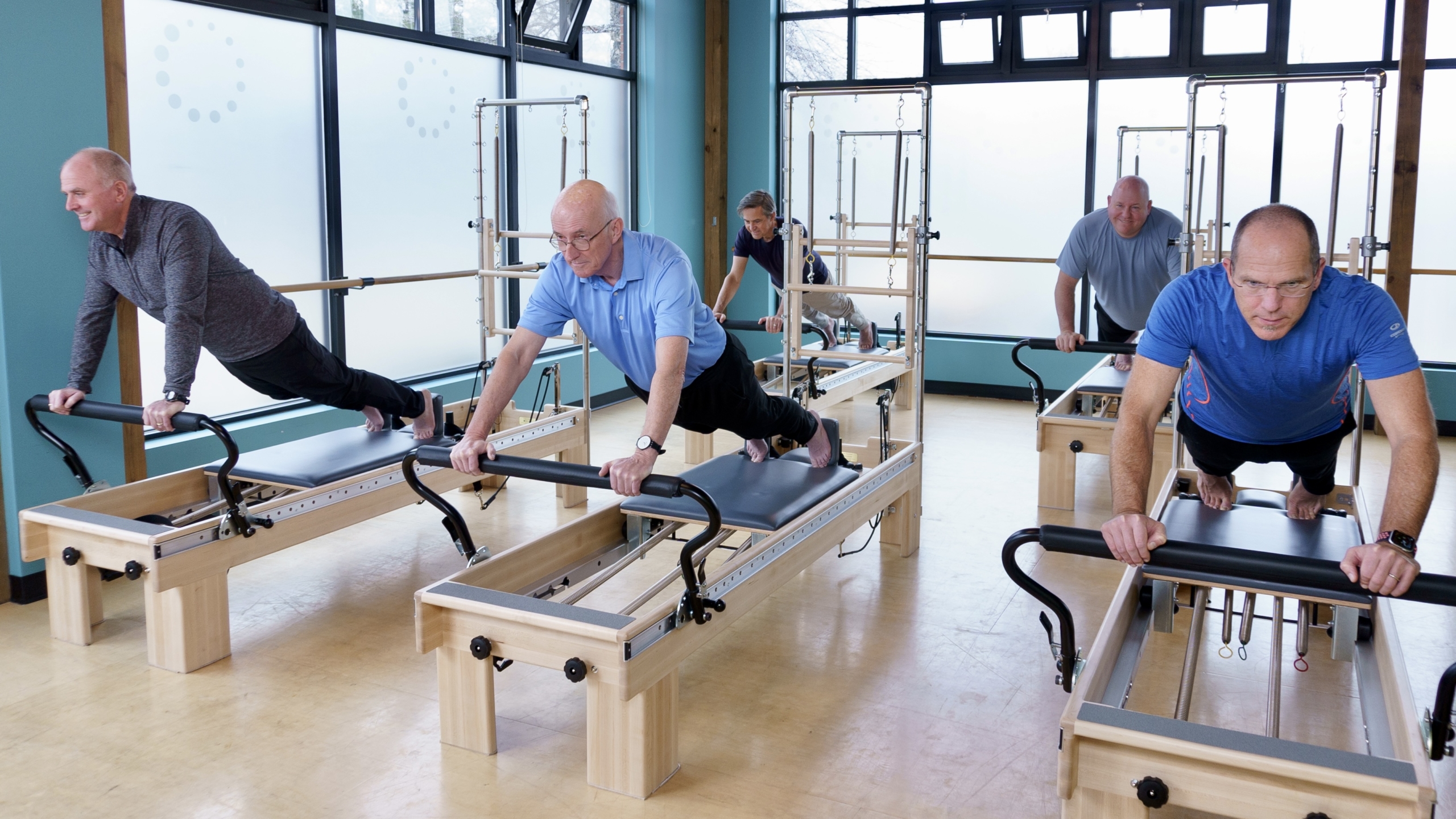
What is Pilates Day?
As an industry, the Pilates community has a shared passion for the work that Joseph Pilates created. Pilates Day is a celebration of that work organized by the Pilates Method Alliance (PMA). The PMA is a professional association for Pilates teachers whose mission is “to advance Pilates as a profession and to promote and perpetuate the teachings of Joseph H. and Clara Pilates.” Pilates Day is set aside annually for the community to come together and highlight this extraordinary movement system. Whether you participate by doing Pilates, teaching Pilates, hosting an event, or learning something new about Pilates, everyone is encouraged to join in and spread the word. It’s all about feeling connected to the Pilates community and celebrating a shared passion.
When is National Pilates Day?
Pilates Day is celebrated annually on the first Saturday in May. You can search online for events in your area. Or, celebrate at home with a free Pilates workout from MOVE Wellness.
Strengthen with Pilates is a great way to build strength using Pilates principles. Join Laura for just 20 minutes to feel strong and supported in your own body in episode 1 of Strengthen with Pilates. No props needed!
What are the benefits of Pilates?
Pilates can help strengthen the body and improve stability and mobility. These improved fitness levels can help prevent injury and give you greater ease of movement through a full range. This system can also relieve low back pain and the postural effects of sitting. It is a safe weight-bearing exercise that can mitigate symptoms of osteoporosis/osteopenia, and there is mounting research that Pilates supports a number of pathologies, postural issues, and is an effective method for whole body strengthening.
Whatever your conditioning goal, Pilates is an efficient, effective, and safe way to increase your flexibility, develop your core, and release tension.
Joseph Pilates said about the effects of his method, “10 sessions — feel the difference, 20 sessions — see the difference, 30 sessions — have a whole new body.”
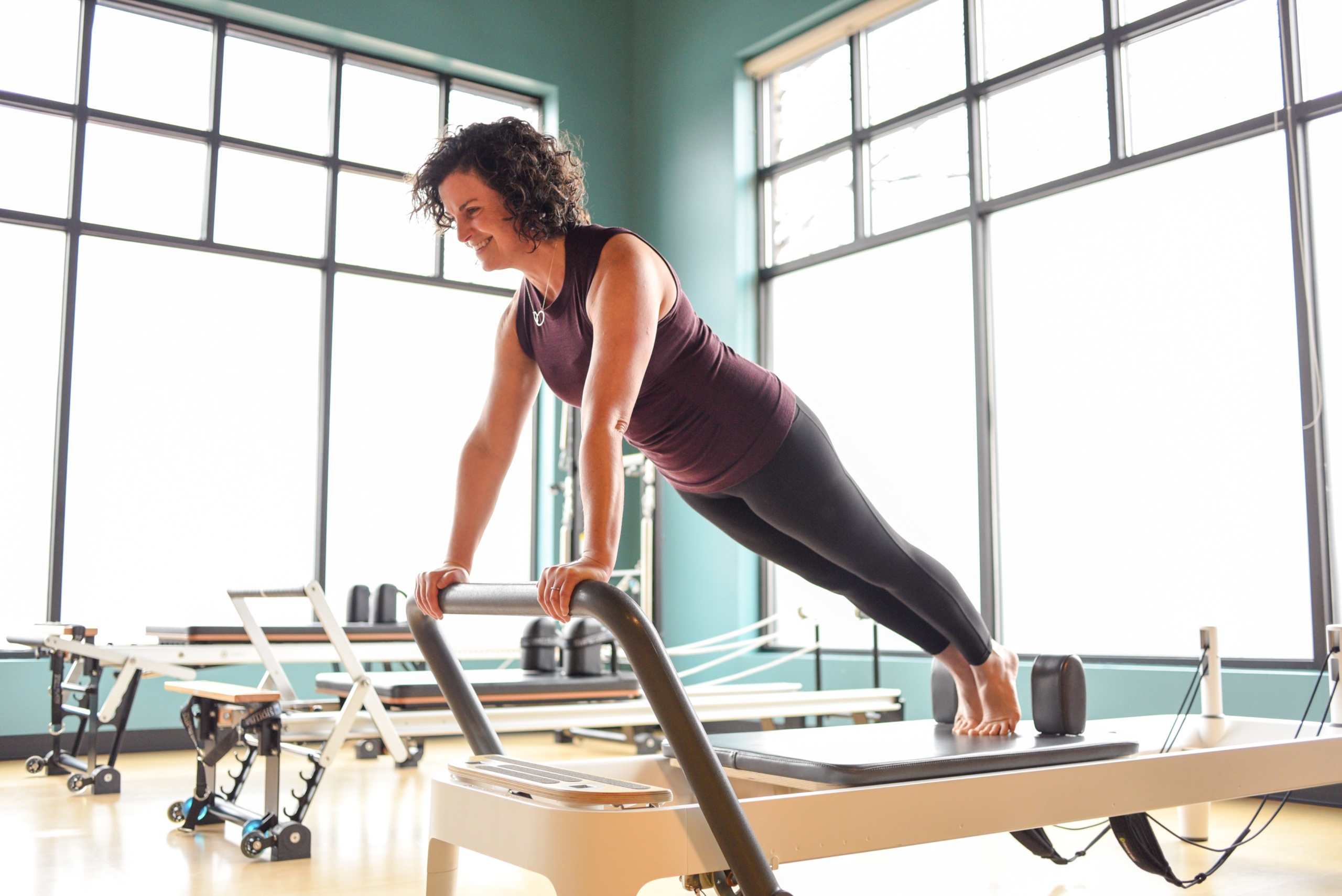
Become a Pilates enthusiast any month of the year
It doesn’t need to be Pilates Day for you to try Pilates! MOVE Wellness offers Pilates classes and private training sessions all year round. Join us in-person at our Ann Arbor, Michigan studio, or online with MOVE On Demand and MOVE Livestream. You can also visit our YouTube channel for more free Pilates videos like the one above.
Contact us today to sign up for an introductory private session or start your first livestream class FREE! We can help you design a Pilates program to help you meet your individual needs and goals.
Say hello to our new friend Revel
“I am incredibly honored to be a part of Revel, a fast-growing, online community of women over forty. We’ve been offered an awesome opportunity to partner with Revel during the months of February and March... We’d love to see your friendly faces in our Revel classes. It’s free and easy to join.“
—Elaine Economou
Revel + MOVE
We’re so excited to share that Revel is launching a special series of MOVE classes featuring Elaine Economou and Laura Tyson throughout February and March.
- Movement Essentials-Pilates Level 1: Tuesdays at 7:00 p.m.
- Barre Class: Wednesdays at Noon
- Mindful Movement & Pilates: Sundays at 5:00 p.m.
- Movement Essentials Pilates Level 2: Mondays at 1:00 p.m.
Beyond February and March, Elaine will continue hosting her monthly Workout Wednesday series on Revel. Join us on the last Wednesday of the month for a brief themed discussion and a Pilates-based class. You’ll learn how to challenge your unique and miraculous body safely and enjoy moving!
Revel will connect you with wonderful women with interests around a variety of topics beyond movement. Enjoy Revel’s recent blogpost “MOVE with Elaine Economou” with registration links for all classes at the end of the Q&A. Everything is free and it’s easy to join!
Starting out with Pilates: How to trust the process (and why you should)
We’re living in a “now” focused world. We can get groceries delivered in an hour and almost anything we want on our doorstep within a day or two. Google “five minute abs” and you’ll see dozens of workouts promising instant success. Starting out with Pilates is a process. I can cut to the chase and say without doubt that the process is absolutely worth it. You’ll get as strong as you want to do all the things you love in life. But you have to accept the invitation to trust the process to get there.
For people who are new to Pilates or other mind-body systems such as GYROTONIC® exercise or yoga, it can be difficult to understand the impact and expectations around the movements. What are you supposed to feel? Too many times I’ve heard people give up too soon saying things like “I’m not sure I feel anything”, “this seems too easy”, or “I’m not sweating enough”. I sometimes wish I could impart a few key pieces of knowledge to them by osmosis to ease them through the bumps of those first few (sometimes confusing) sessions.
What is Pilates?
Simply stated, Pilates is a series of exercises that can be done on a mat or specialized equipment. But it’s really so much more. Pilates is also a complete system of movement that can be applied to other fitness programs to make them more effective. This unique, whole body system was developed by forward-thinking visionary Joseph Pilates 100 years ago. It evolved throughout his lifetime and continues to do so today.
The goal of a Pilates session is to move through the repertoire of exercises at the level and pace that suits you. We’ll move your spine in all planes of motion and challenging your body with different relationships to gravity. The original Pilates exercises focused simply on the body and breathwork. Over time, various props and specialized equipment became integrated into the movement system.
Getting started with Pilates
As you prepare to begin a Pilates practice, it’s important to start at the beginning to build the vocabulary and understand the concepts. Serious athletes may be able to jump into an advanced class and be able to do the movements, but without taking time to master the Pilates basics, their benefits will be limited by a lack of understanding and foundation. No one would try to build a skyscraper without a solid foundation.
As you feel the movement principles of Pilates in your own body you will start to connect to the organization of the exercises. This is when the magic starts to happen. As ability, strength, and coordination increase, we can add complexity and more challenges. You will see your strength, balance, and mobility improve with consistent practice and without the “no pain no gain” mentality that typically comes with fitness training. The best part is that everything you love to do will get easier, including regular, daily life.
Trusting the process in Pilates
So how do you get there? Understanding some common truths can lead to a much smoother experience of learning the movements, breathing, expectations, and coordination to maximize the impact of this work. After more than twenty years of teaching Pilates here a few things I know to be true for people at any age or stage when meeting this work:
1. Everyone gets it.
Yep, if you show up consistently you will learn to connect the breath, movement, and coordination to execute the exercises. Happens every time. In Pilates we use breathing to connect to muscular activation of tissues and breathing optimally brings tone to the deep support structures of the trunk. Most importantly, it brings awareness into the body and is a tool to help you start to become more aware of your body as it moves.
People feel unsure and worry that they are inhaling and exhaling at all the wrong times. Or, clients might come in for a session and think why are we spending so much time *just* breathing? Your trainer can help with a plan just for you and there’s a reason behind everything you’re doing. I promise that everyone can learn to move and breathe at the same time.
2. It’s not your typical workout.
Pilates is a system of mindful movement. It requires the act of listening to your body to help you organize the movement organically. Joseph Pilates said “It is the mind itself which shapes the body.” He didn’t mean that you bench pressed a ton of weight, but that you build the awareness you need to move the body with ease, strength and control. That control comes not from a performative execution of exercises, but from noticing what is happening in your unique body. Understanding the body in relationship to its various parts is what allows for successful coordination of complex movements.
In a small fitness studio like MOVE Wellness, your trainer will ask questions about how and what you feel while executing movements. The idea is to listen, notice, and connect — both trainer and client — based on what the trainer sees and on the client’s goals. While we teach specific movement practices like Pilates, GYROTONIC® exercise, barre and yoga at our studio, the goal is to use those forms to empower people of any age and fitness level to be strong, healthy and capable of moving in ways that make them happy — walking, running, gardening, crafting, dancing, morel mushroom foraging, or whatever it may be.
3. It’s not one size fits all.
When you show up for a Pilates session, we’re going to meet your body where it’s at. It can be tempting to come in looking for a quick fix. And easy to be impatient for the twinge in your back or the ache in your knees to resolve immediately. But all of this work will be done within the level that’s right for your body, and your age and stage of life. I often say that we are working at the pace of the client’s body, not their mind. In our quick results oriented culture, the deep efficiency of our work is moving in relationship with your body, not against it.
Your body is unique, with issues and alignment specific to you. Pilates trainers certified by the NPCP have done rigorous training that means they can help support a variety of pathologies or postural issues. It can be tough after just one session to feel totally different in your body. At first it might feel too easy while you adjust to a different type of sensation. It will quickly become a full body workout once the coordination and capacity for listening and feeling the movement in our body occurs. Change takes time. Part of the work is committing to regular movement so that you actually give yourself the chance to see noticeable change. Through the practice of Pilates, you will increase understanding of your own body and how to care for it through movement.
4. It can be a vulnerable process.
We know that people come to us with so many layers of our culture’s imprint in their psyche about their body. It is a privilege to be with our clients and help them have an enjoyable experience moving. Pilates offers something for everyone and for every body. We will optimize your body for what you love to do in life and bring ease and balance to support that. It’s about more than being defined by just musculature — it’s thinking about fitness as resilience.
This is so different from the messages we get daily in our culture. We are told that doing all those crunches for core strength will flatten your belly or help your back pain. But what if your back pain is due to something happening with your feet or neck? What if doing all those crunches to get an abdominal six pack pulls your pelvic floor so taut that you start to have incontinence? Pilates is a whole body system of movement. We’ll focus on individual postural issues that help each person unravel their own unique muscular imbalances to create healthy movement patterns.
Nothing gives us more pleasure than when a client jumps up and says that the time flew by and they feel great!
5. There are no shortcuts.
You have to go through the forest. That’s something I like to say to my clients and instructor trainees. What I mean is that Pilates is a process of organizing movement and embodying the principles of human movement. There’s not a straight, paved path from your starting point to your end goal. Think of the body as a system. We will target the whole system to move optimally, not just one muscle. It can take a lot of time and patience to make progress.
It takes intentional movement to build strength and understand your own body. Along this journey, you will challenge yourself with more complex movements and layer in resistance from the Pilates equipment or your own body weight. You will learn to identify and overcome your own personal tendencies and compensations to optimize your movements. The goal is to build up to a full body workout that uses pace, weight and complexity to effectively meet the needs of your unique body.
Start your own Pilates journey
This is a process, and I encourage clients to trust it. It will not be the pace of the mind but it will be the pace of your unique body. Building the deep strength and organization to support your goals is an act of listening and building awareness of the needs of your body moment by moment. Trusting the process means showing up, committing to the work, and having confidence in the journey.
Pilates can be an ideal fitness program for a wide range of people at a variety of ages and stages. Get started with the movement essentials from the comfort of your home. Or, schedule an introductory session with one of our professional trainers.
Pilates for pelvic floor health
We’re proud to share that this blog post has been published in the April 2022 issue of The Brick Magazine!
One of the most important things to understand about pelvic health is that your pelvis is part of a larger integrated system. Each of us has a unique physical structure. And once we take the time to understand the structure of our bodies and how individual parts work together, developing our overall health and well-being becomes considerably easier.
Equally important is the simple fact that anyone can improve their pelvic floor health through smart, effective movement and exercise. Simple Pilates exercises can help strengthen your pelvic floor and bring more awareness to your body.
Sign up for an introductory package for an assessment of your individual needs and customized instruction.
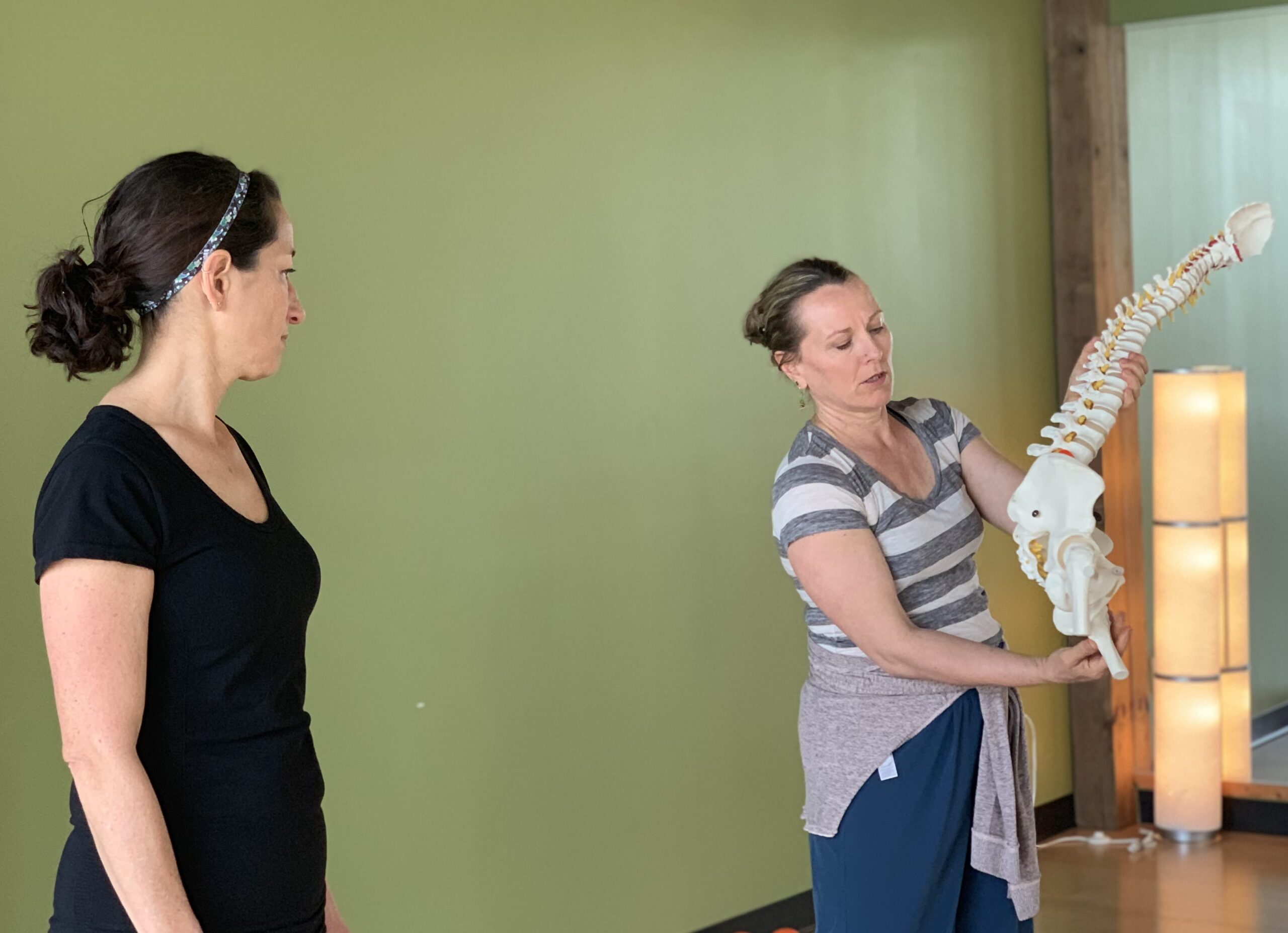
What is the pelvic floor?
Your pelvic floor is a network of muscles that spread across the bottom of your pelvic cavity like a hammock. They have many functions including supporting the pelvic organs such as the uterus, bladder, and rectum. They also help to withstand increases in pressure that occur in the abdomen with activities such as coughing and sneezing, and they help to enhance the sexual response. These are the muscles you are targeting when doing Kegels.
Many women have probably heard of Kegels, but did you know that studies have shown that most women are unable to perform a proper Kegel contraction without some education? It takes diligence, awareness, and practice to perform an effective pelvic floor contraction or a Kegel. This is where body awareness and Pilates can be helpful.
Benefits of Pilates for the pelvic floor
- Releases stress
- Relieves low back pain
- Builds core strength
- Helps improve pelvic floor disorders, including urinary incontinence
“How can I tighten my pelvic floor muscles fast?” It’s not just about Kegel exercises
When it comes to your pelvic health, “slow and steady” truly does win the race. Unfortunately, so many of us are taught to approach exercise fast and furiously. So, if you’re one of those people who always assumed that any good exercise requires squeezing the bejesus out of whatever muscle you’re trying to work, congratulations, you don’t have to do that anymore.
True pelvic health means moving beyond the notion of simply doing targeted exercises like Kegels and muscling through things, and instead working more organically, starting with our basic alignment and breath.
Performing isometric exercises like Kegels without a basic understanding of your own structure and the shape and needs of your pelvic floor can actually have a negative impact. Which is why working through pelvic pain or discomfort is never a good idea. The goal is always to reconnect your body’s natural movement system to restore healthy patterns.
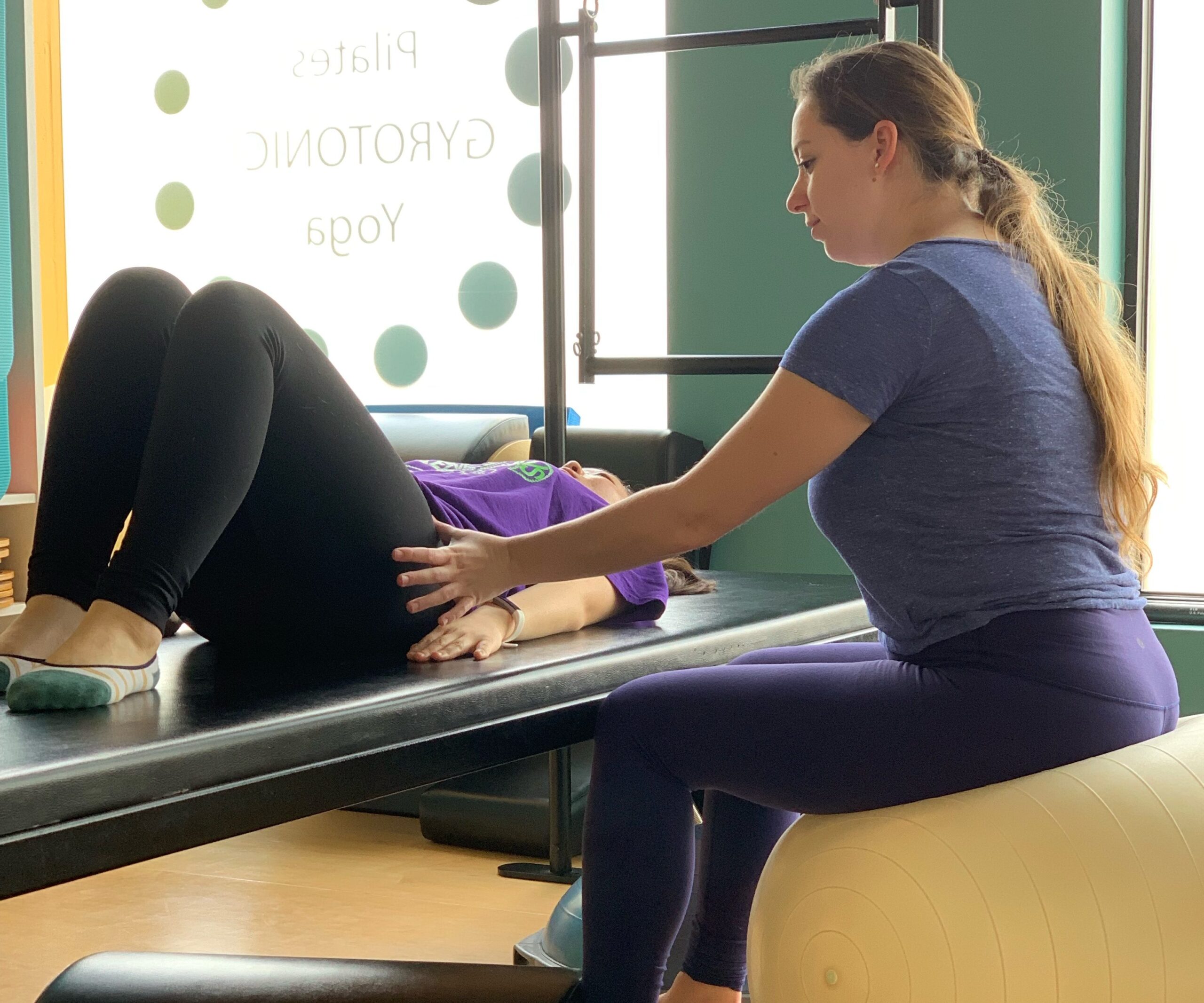
Gentle Pilates, GYROTONIC® exercise and pelvic floor awareness
Engaging in specific simple exercises on a daily basis will have the greatest impact on your body. Which is why working with someone who has professional expertise can be essential for starting things off right.
Movement professionals such as pelvic health physical therapists, Pilates instructors and GYROTONIC® method trainers can see things in your body and the way you move that you simply can’t or are not yet aware of. Having eyes on your body in that way can help you more quickly unravel any postural issues or imbalances you might have and help you find proper alignment to help you work effectively on your own.
Just becoming aware of your pelvic floor – what it is and how it feels – is a helpful first step for most of us. Because although we think we understand it in theory, many of us very rarely take the time to stop and get a true sense of how it feels. You can help build awareness of the pelvic floor with these four easy steps:
Step 1: Try this exercise for pelvic floor awareness
Sit upright on a chair with a lengthened spine. Take a few deep breaths, letting your ribs expand on the inhale and contract on the exhale.
Take notice of the bony parts on either side of your pelvis, which are commonly referred to as your “sits bones.” While continuing to sit upright, just gently rock from side to side, from one sits bone to the other. As you do this, try to imagine your Take notice of the bony parts on either side of your pelvis, which are commonly referred to as your “sits bones.” While continuing to sit upright, just gently rock from side to side, from one sits bone to the other. As you do this, try to imagine your tailbone in the back and your pubis symphisis in the front, which is the joint between your two pubic bones. You won’t really be able to feel the tailbone or pubis symphisis, but imagining them centrally situated in relation to your sits bones can give you an overall sense of your pelvic floor.
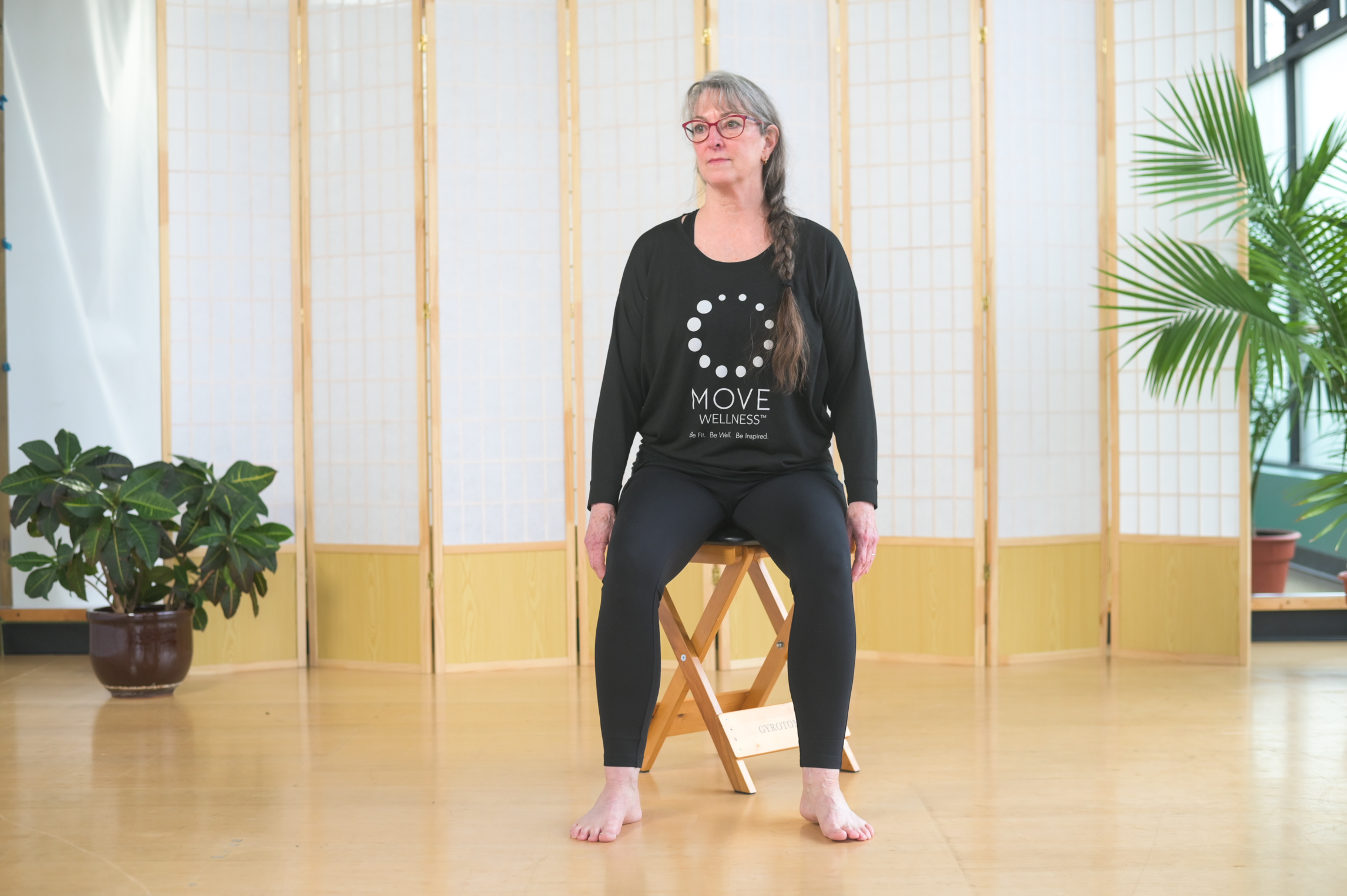
Step 2: Gentle engagement of the pelvic floor
Now with all those four points in mind, settle into the middle of your chair again and think about the tissue contained within those four points. That’s what you want to think about when we talk about engaging the pelvic floor. But that engagement should be a subtle sensation, not an intense squeeze.
The muscles and tissue here work differently; it’s not like flexing a bicep or squeezing a glute muscle. Performing gentle Kegels should feel like a lift and narrowing of the pelvic floor tissue rather than a squeeze.
Step 3: Learning to breathe optimally
Breathing. Meditation. Mindfulness. We talk and hear about these concepts a lot, and know they’re important. But it can be hard to really understand why and then put them into practice in ways we find useful.
Breath work is what I like to think of as a “clean slate” exercise. We have little to no sense of how we actually feel or what’s going on with our bodies if we don’t take a moment to breath first. For most of us, we often skip this step simply because we feel like we don’t have the time for it. But beginning with the breath gives us a starting point; a place where we can become aware of what’s happening with our body and can gauge any changes as we progress through movement.
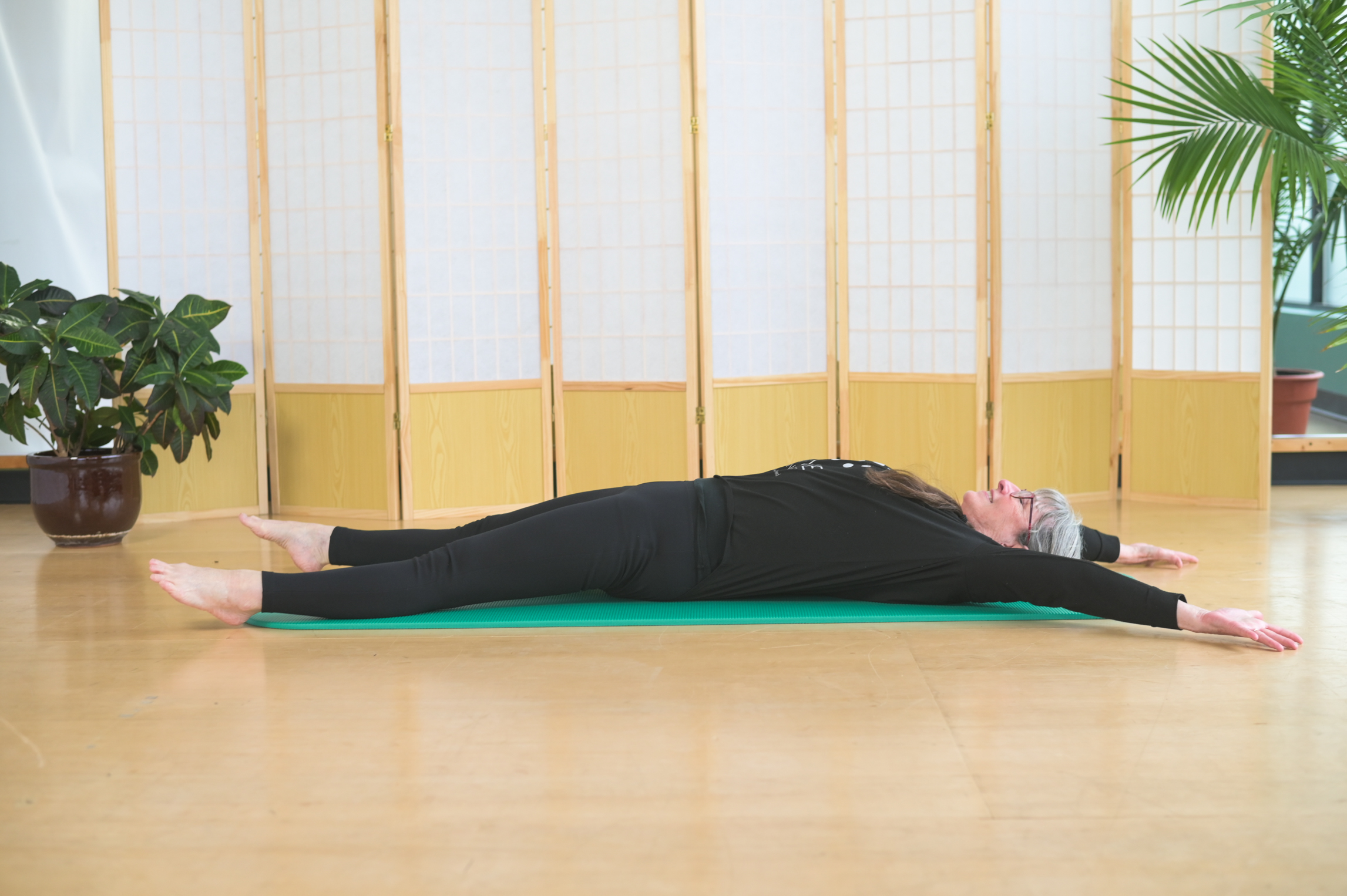
You can work on breathing while sitting upright or lying down. Start by simply letting your body relax and taking a few easy breaths. And as you breath, notice where you feel the breath expanding in your body. Chest? Ribs? Belly?
From there, picture your full ribcage. And as you breath, think about sending the breath into the back and sides of the ribcage.
Then, imagine your body as similar to a balloon. On the inhale, fill the balloon with air, and then picture the tissue and muscles of your pelvic floor gently lifting with the balloon on the exhale, all while keeping the rest of your body fairly still.
Your abdominals might contract slightly, but otherwise you should try not to move your pelvis, glutes or hip flexors. Keep your bones and bigger muscles still.
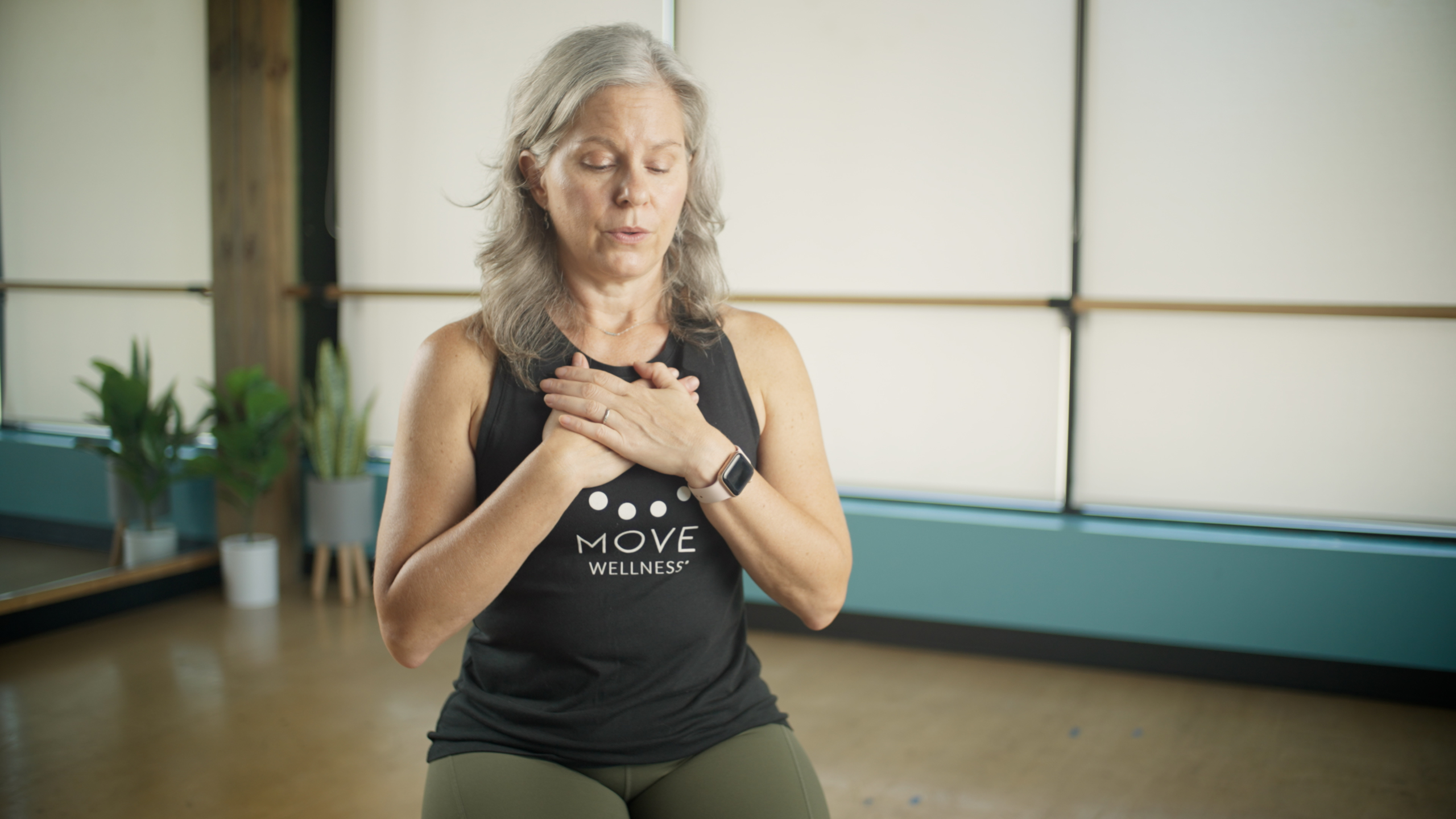
Step 4: Gentle breathing and lifting the pelvic floor
It will take some time and practice to do this without automatically trying to force or overwork your muscles. And that’s why starting small with that simple pelvic awareness is important. It helps you build the organic contractions and stimulation you’re aiming for and avoid any bearing down or pushing out. Ultimately, it should feel as though there’s a little sling or hammock lifting everything up and releasing down.
Safe, effective pelvic floor exercises
There are several simple, everyday Pilates exercises focusing on the spine, hips, abdominals and legs that are perfect for building and maintaining pelvic health. And you’ve most likely heard about or tried at least a few of them.
Stretches for the back and spine such as cat stretch, hip rolls, hip release and spinal rotation. Simple abdominal exercises like leg slides, single leg lifts and the side leg series. All of these stretches and exercises can be learned quickly and easily performed at home on a daily basis.
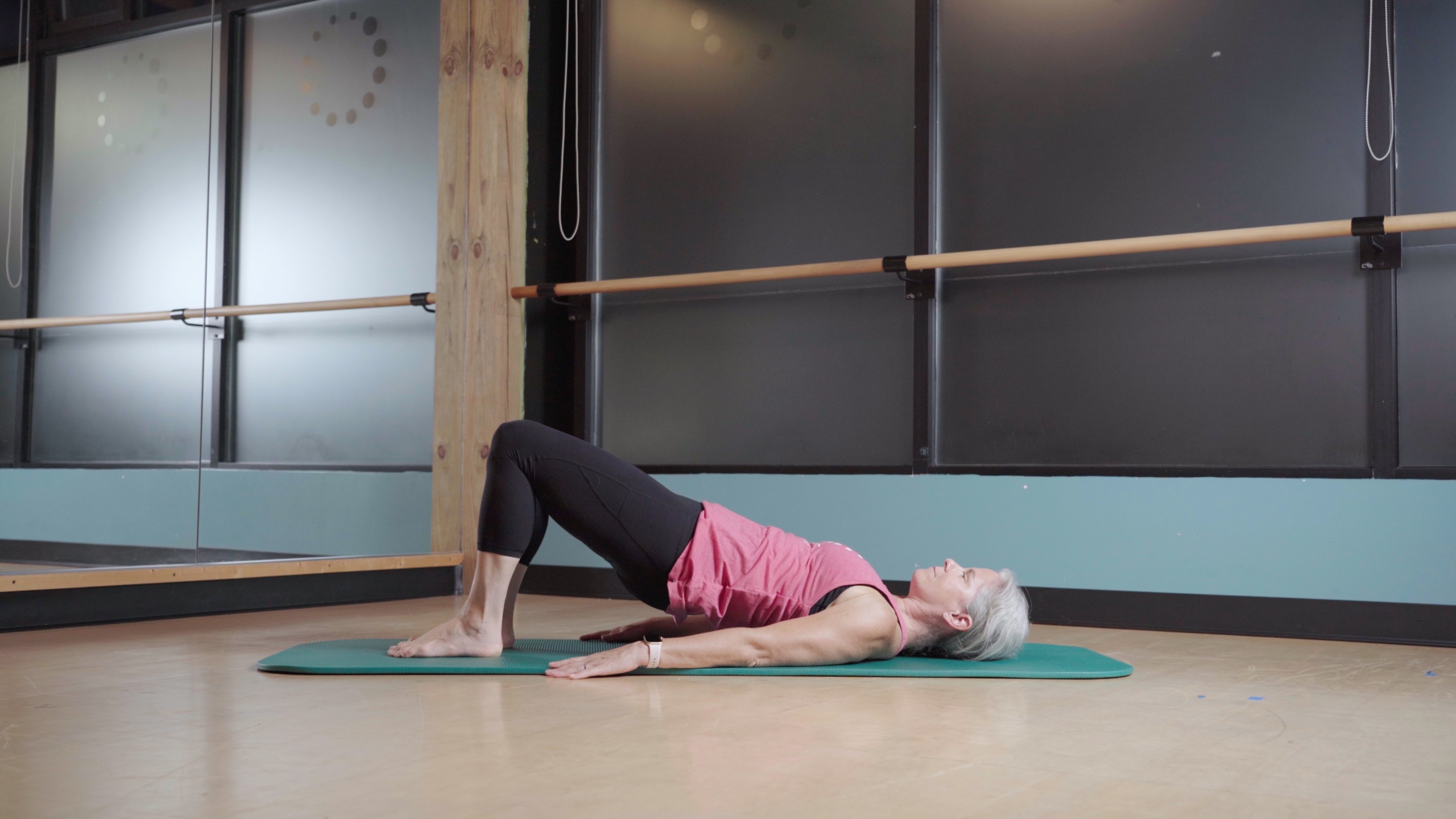
Learn pelvic health exercises with gentle Pilates training
The primary reason we encourage newcomers at MOVE to sign up for an introductory package is because it’s hands down the best way for us to assess your individual needs and help you develop a safe, effective routine going forward.
One size does not fit all when it comes to our bodies and our pelvic health (or anything else for that matter), which makes customized instruction essential. Having expert eyes properly assess your body’s movement patterns and then having a one-on-one conversation with someone about your individual lifestyle and health goals is something we all need and deserve.
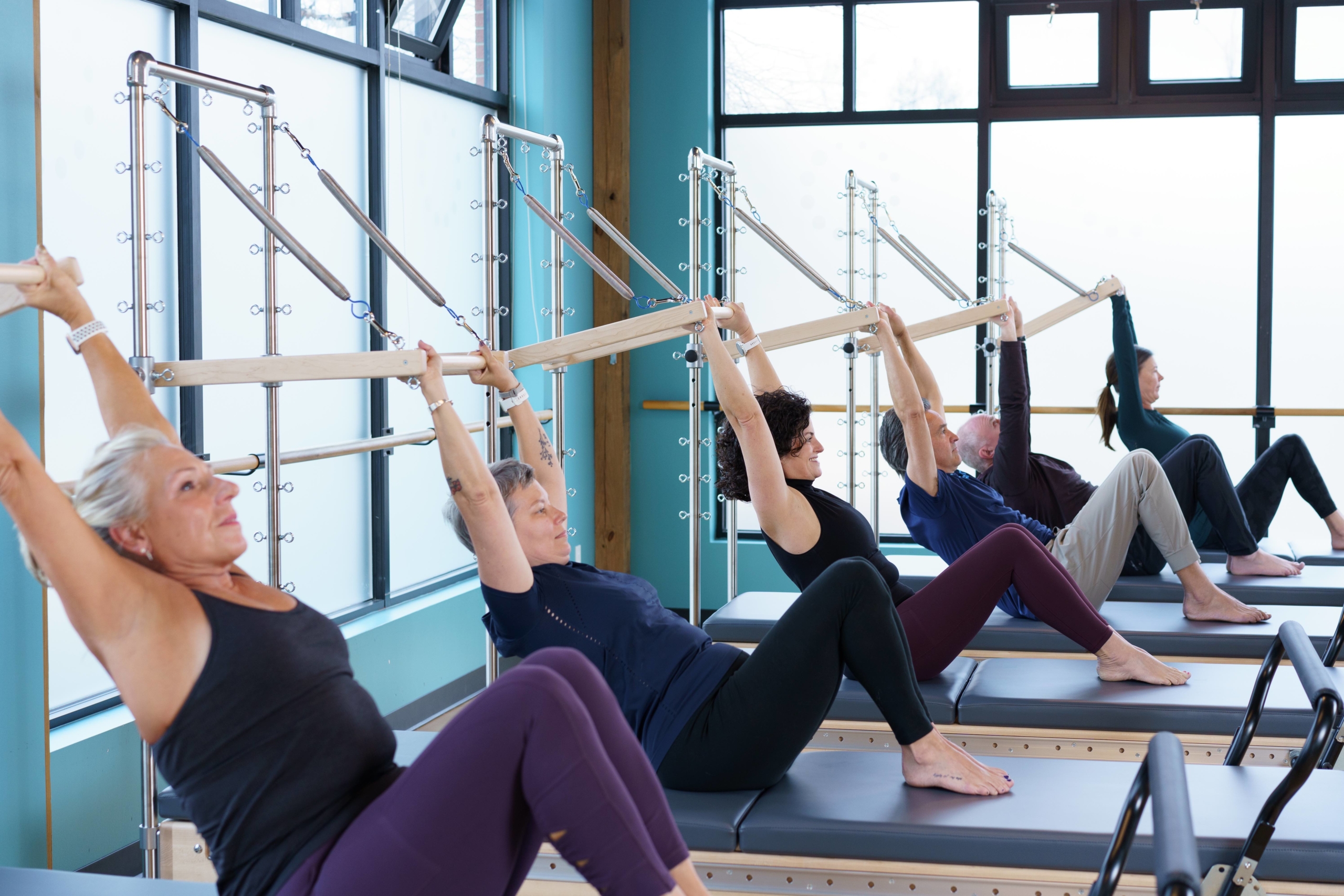
Private Pilates training vs. small group classes
For some people, starting with private training to get that extra individual support works best. And for others, signing up for gentle and beginner level Pilates classes and Gyrokinesis classes after an initial assessment is the perfect way to get hands-on training in a small, supportive group environment.
Ready to find that pelvic lift? Call our studio at 734-224-2560 or email us at office@movewellness.com to sign up for an introductory session today.
There will be no pelvic floor left behind!
Pilates for pelvic floor health
We’re proud to share that this blog post has been published in the April 2022 issue of The Brick Magazine!
One of the most important things to understand about pelvic health is that your pelvis is part of a larger integrated system. Each of us has a unique physical structure. And once we take the time to understand the structure of our bodies and how individual parts work together, developing our overall health and well-being becomes considerably easier.
Equally important is the simple fact that anyone can improve their pelvic floor health through smart, effective movement and exercise. Simple Pilates exercises can help strengthen your pelvic floor and bring more awareness to your body.
Sign up for an introductory session for an assessment of your individual needs and customized instruction.

What is the pelvic floor?
Your pelvic floor is a network of muscles that spread across the bottom of your pelvic cavity like a hammock. They have many functions including supporting the pelvic organs such as the uterus, bladder, and rectum. They also help to withstand increases in pressure that occur in the abdomen with activities such as coughing and sneezing, and they help to enhance the sexual response. These are the muscles you are targeting when doing Kegels.
Many women have probably heard of Kegels, but did you know that studies have shown that most women are unable to perform a proper Kegel contraction without some education? It takes diligence, awareness, and practice to perform an effective pelvic floor contraction or a Kegel. This is where body awareness and Pilates can be helpful.
Benefits of Pilates for the pelvic floor
- Releases stress
- Relieves low back pain
- Builds core strength
- Helps improve pelvic floor disorders, including urinary incontinence
“How can I tighten my pelvic floor muscles fast?” It’s not just about Kegel exercises
When it comes to your pelvic health, “slow and steady” truly does win the race. Unfortunately, so many of us are taught to approach exercise fast and furiously. So, if you’re one of those people who always assumed that any good exercise requires squeezing the bejesus out of whatever muscle you’re trying to work, congratulations, you don’t have to do that anymore.
True pelvic health means moving beyond the notion of simply doing targeted exercises like Kegels and muscling through things, and instead working more organically, starting with our basic alignment and breath.
Performing isometric exercises like Kegels without a basic understanding of your own structure and the shape and needs of your pelvic floor can actually have a negative impact. Which is why working through pelvic pain or discomfort is never a good idea. The goal is always to reconnect your body’s natural movement system to restore healthy patterns.

Gentle Pilates, GYROTONIC® exercise and pelvic floor awareness
Engaging in specific simple exercises on a daily basis will have the greatest impact on your body. Which is why working with someone who has professional expertise can be essential for starting things off right.
Movement professionals such as pelvic health physical therapists, Pilates instructors and GYROTONIC® method trainers can see things in your body and the way you move that you simply can’t or are not yet aware of. Having eyes on your body in that way can help you more quickly unravel any postural issues or imbalances you might have and help you find proper alignment to help you work effectively on your own.
Just becoming aware of your pelvic floor – what it is and how it feels – is a helpful first step for most of us. Because although we think we understand it in theory, many of us very rarely take the time to stop and get a true sense of how it feels. You can help build awareness of the pelvic floor with these four easy steps:
Step 1: Try this exercise for pelvic floor awareness
Sit upright on a chair with a lengthened spine. Take a few deep breaths, letting your ribs expand on the inhale and contract on the exhale.
Take notice of the bony parts on either side of your pelvis, which are commonly referred to as your “sits bones.” While continuing to sit upright, just gently rock from side to side, from one sits bone to the other. As you do this, try to imagine your Take notice of the bony parts on either side of your pelvis, which are commonly referred to as your “sits bones.” While continuing to sit upright, just gently rock from side to side, from one sits bone to the other. As you do this, try to imagine your tailbone in the back and your pubis symphisis in the front, which is the joint between your two pubic bones. You won’t really be able to feel the tailbone or pubis symphisis, but imagining them centrally situated in relation to your sits bones can give you an overall sense of your pelvic floor.

Step 2: Gentle engagement of the pelvic floor
Now with all those four points in mind, settle into the middle of your chair again and think about the tissue contained within those four points. That’s what you want to think about when we talk about engaging the pelvic floor. But that engagement should be a subtle sensation, not an intense squeeze.
The muscles and tissue here work differently; it’s not like flexing a bicep or squeezing a glute muscle. Performing gentle Kegels should feel like a lift and narrowing of the pelvic floor tissue rather than a squeeze.
Step 3: Learning to breathe optimally
Breathing. Meditation. Mindfulness. We talk and hear about these concepts a lot, and know they’re important. But it can be hard to really understand why and then put them into practice in ways we find useful.
Breath work is what I like to think of as a “clean slate” exercise. We have little to no sense of how we actually feel or what’s going on with our bodies if we don’t take a moment to breath first. For most of us, we often skip this step simply because we feel like we don’t have the time for it. But beginning with the breath gives us a starting point; a place where we can become aware of what’s happening with our body and can gauge any changes as we progress through movement.

You can work on breathing while sitting upright or lying down. Start by simply letting your body relax and taking a few easy breaths. And as you breath, notice where you feel the breath expanding in your body. Chest? Ribs? Belly?
From there, picture your full ribcage. And as you breath, think about sending the breath into the back and sides of the ribcage.
Then, imagine your body as similar to a balloon. On the inhale, fill the balloon with air, and then picture the tissue and muscles of your pelvic floor gently lifting with the balloon on the exhale, all while keeping the rest of your body fairly still.
Your abdominals might contract slightly, but otherwise you should try not to move your pelvis, glutes or hip flexors. Keep your bones and bigger muscles still.

Step 4: Gentle breathing and lifting the pelvic floor
It will take some time and practice to do this without automatically trying to force or overwork your muscles. And that’s why starting small with that simple pelvic awareness is important. It helps you build the organic contractions and stimulation you’re aiming for and avoid any bearing down or pushing out. Ultimately, it should feel as though there’s a little sling or hammock lifting everything up and releasing down.
Safe, effective pelvic floor exercises
There are several simple, everyday Pilates exercises focusing on the spine, hips, abdominals and legs that are perfect for building and maintaining pelvic health. And you’ve most likely heard about or tried at least a few of them.
Stretches for the back and spine such as cat stretch, hip rolls, hip release and spinal rotation. Simple abdominal exercises like leg slides, single leg lifts and the side leg series. All of these stretches and exercises can be learned quickly and easily performed at home on a daily basis.

Learn pelvic health exercises with gentle Pilates training
The primary reason we encourage newcomers at MOVE to sign up for an introductory session is because it’s hands down the best way for us to assess your individual needs and help you develop a safe, effective routine going forward.
One size does not fit all when it comes to our bodies and our pelvic health (or anything else for that matter), which makes customized instruction essential. Having expert eyes properly assess your body’s movement patterns and then having a one-on-one conversation with someone about your individual lifestyle and health goals is something we all need and deserve.

Private Pilates training vs. small group classes
For some people, starting with private training to get that extra individual support works best. And for others, signing up for gentle and beginner level Pilates classes and Gyrokinesis classes after an initial assessment is the perfect way to get hands-on training in a small, supportive group environment.
Ready to find that pelvic lift? Call our studio at 734-224-2560 or email us at office@movewellness.com to sign up for an introductory session today.
There will be no pelvic floor left behind!
